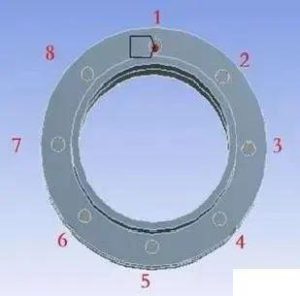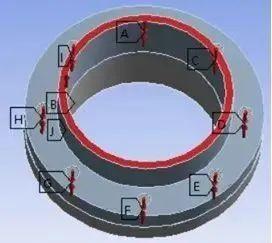The Bolt that Loosens First in a Bolted Connection Is Less Likely to Break?
Who breaks first when a bolt comes loose is a highly debated topic. In general cognition, the bolt that is loosened first will not break. Because the bolts that loosen first are subjected to less force than those that are tightened. But is this really the case? In this article, TorcStark will subvert everyone’s cognition based on the case analysis results.
First of all, it is necessary to find out the degree of looseness and what kind of load the bolt group bears, so as to judge whether the first loose bolt will break first.
Three situations are discussed below.
1. If it is only subject to static load
The bolt that is loosened first will not break first. If the bolt is loose, it means that the pre-tightening force becomes smaller or the pre-tightening force is zero. The smaller the pre-tightening force, the smaller the comprehensive working stress of the bolt under the action of external load. The bolt with the least working stress will not break first under the static load condition.
Now take the bolt connection in the flange connection as an example to see what happens to the stress of the bolt if one bolt is loose.
8 M16 grade 10.9 bolts connect the following flanges, and the bolt numbers are as follows:


Under normal circumstances, the same preload is applied to the bolts. Assuming that the pre-tightening force of the bolts is 98KN, if one bolt is loose, it means that the pre-tightening force is reduced or there is no pre-tightening force. Here, the pre-tightening force of bolt 1 is set to 30KN, which is 68KN less than the pre-tightening force of other bolts. When the flange bears 600KN tension, see the difference in the force of the bolts.




The stress of the bolts is shown in the table below:
| Type | Bolt Pretension | |||||||
| Boundary Condition | Bolt Pretension 1 | Bolt Pretension 2 | Bolt Pretension 3 | Bolt Pretension 4 | Bolt Pretension 5 | Bolt Pretension 6 | Bolt Pretension 7 | Bolt Pretension 8 |
| Working Load | 68706 N | 1.2644e+005 N | 1.2174e+005 N | 1.2004e+005 N | 1.1943e+005 N | 1.2004e+005 N | 1.2117e+005 N | 1.2644e+005 N |
It can be seen from the analysis results that the stress distribution of all bolts is changed due to the relaxation of bolt 1. The loose bolt receives less tension, and the two bolts immediately adjacent to the loose bolt (numbers 2 and 8) experience more tension. A large tensile force means that the internal stress is relatively large. If the load continues to increase, the two bolts will break first.
2. If the bolt group is subjected to fatigue loads
The bolt is entirely loose (that is, there is no pre-tightening force), and even under the action of external load, the bolt will not be stressed. The bolt next to it bears the force it should bear, so the bolt that is loosened first will not break first, and the bolt adjacent to it may break first. Taking the flange connection as an example, one bolt is entirely loose, that is, the pre-tightening force is zero, and the pre-tightening force of other bolts is still 98KN.
| Type | Bolt Pretension | |||||||
| Boundary Condition | Bolt Pretension 1 | Bolt Pretension 2 | Bolt Pretension 3 | Bolt Pretension 4 | Bolt Pretension 5 | Bolt Pretension 6 | Bolt Pretension 7 | Bolt Pretension 8 |
| Working Load | 0 N | 1.4879e+005 N | 1.2534e+005 N | 1.2025e+005 N | 1.1918e+005 N | 1.2026e+005 N | 1.2534e+005 N | 1.4877e+005 N |
From the above results, it can be seen that when the flange connection is subjected to external loads, completely loose bolts do not bear tension, that is, the tension is zero. When the flange is subjected to alternating loads from 0 to 600KN, the tension variation range of each bolt is:
| Bolt 1 | Bolt 2 | Bolt 3 | Bolt 4 | Bolt 5 | Bolt 6 | Bolt 7 | Bolt 8 | |
| Pretension KN | 0 | 98 | 98 | 98 | 98 | 98 | 98 | 98 |
| Bolt force KN | 0 | 148 | 125 | 120 | 119 | 120 | 125 | 148 |
| Force range KN | 0 | 50 | 27 | 22 | 21 | 22 | 27 | 50 |
From the fatigue characteristics of bolts, it can be seen that the larger the stress variation range of bolts, the earlier fatigue fracture occurs and the shorter the fatigue life.
Therefore, the two adjacent bolts on both sides of the fully loosened bolt are the first to fatigue fracture, while the fully loosened bolt will not break.
3. If the bolt is only reduced in preload
Then under the action of fatigue load, its comprehensive stress range will become larger, the fatigue life will be lower than the design life, and fatigue fracture may occur first.
Assuming that the pre-tightening force of the bolts is 98KN, if one bolt is loose, it means that the pre-tightening force is reduced or there is no pre-tightening force. Here, the pre-tightening force of bolt 1 is set to 30KN, which is 68KN less than the pre-tightening force of other bolts. When the flange is subjected to alternating tension from 0 to 600KN, calculate the stress and tension variation range of the bolts:
| Type | Bolt Pretension | |||||||
| Boundary Condition | Bolt Pretension 1 | Bolt Pretension 2 | Bolt Pretension 3 | Bolt Pretension 4 | Bolt Pretension 5 | Bolt Pretension 6 | Bolt Pretension 7 | Bolt Pretension 8 |
| Working Load | 68706 N | 1.2644e+005 N | 1.2174e+005 N | 1.2004e+005 N | 1.1943e+005 N | 1.2004e+005 N | 1.2117e+005 N | 1.2644e+005 N |
| Bolt 1 | Bolt 2 | Bolt 3 | Bolt 4 | Bolt 5 | Bolt 6 | Bolt 7 | Bolt 8 | |
| Pretension KN | 30 | 98 | 98 | 98 | 98 | 98 | 98 | 98 |
| Bolt force KN | 68 | 126 | 121 | 120 | 119 | 120 | 121 | 126 |
| Force range KN | 38 | 28 | 23 | 22 | 21 | 22 | 23 | 28 |
From the calculation results in the above table, it can be seen that the force variation range of the incompletely loosened bolt and its two adjacent bolts is relatively large, so the incompletely relaxed bolt and the two adjacent bolts on both sides are the first to undergo fatigue fracture.
Summing-up
Through actual application and data analysis, whether the first loosened bolt breaks first should be judged according to the actual situation. Under different circumstances, a loose bolt will be subjected to different forces with different results. Here is TorcStark for the perfect bolting solution. If you have any questions about bolts, please contact us, TorcStark will provide you with solutions for free.


